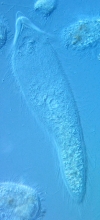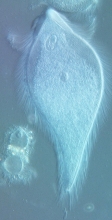UPDATE - 11/30@2:34PM: FANTOONS created this awesome toon inspired by this story. Well done! :)
Geddy, Alex & Neil.
- Fantoons (@Fantoons) November 30, 2017
For more Rush toons here: https://t.co/CYRLHAOQEG pic.twitter.com/L9K5LaKT02
----- snip -----
UPDATE - 11/28@12:30PM: Rush reacted to the news via this Twitter post:
Having a microbe named after each of us is a hugely tiny honour! Love it
----- snip -----
UPDATE - 11/27@2:15PM: John at Cygnus-X1.net sent along this photo of Patrick Keeling and Javier del Campo in the lab wearing their Rush t-shirts.


 Researchers at the University of British Columbia have named three new species of microbe found in the guts of termites after the three members of Rush due to the microbes' long hair and rhythmic wriggling under the microscope. From the University of British Columbia website:
Researchers at the University of British Columbia have named three new species of microbe found in the guts of termites after the three members of Rush due to the microbes' long hair and rhythmic wriggling under the microscope. From the University of British Columbia website:
... "A Spanish postdoc, Javier del Campo, asked me to recommend some good Canadian music, and I suggested he listen to Rush," says Patrick Keeling, a University of British Columbia microbiologist and senior author on the paper describing the new species. "He came back to me and said 'Those microbes we're finding have long hair like the guys on the album 2112!'"
The microbes in question are covered with flagella, which are long threads that cells use to move around. Many cells have a few flagella, but these little rockers have more than ten thousand very long flagella, giving them flowing hair that even Farrah Fawcett might envy.
And while Rush may not be famous for their dance moves, the tiny creatures also have rhythm. They bob their heads and sway their bodies in microscopic dances, prompting the researchers to baptize the new Pseudotrichonympha species P. leei, P. lifesoni, and P. pearti after musicians Geddy Lee, Alex Lifeson and Neil Peart.
The prototypical Canadian power trio is known for songs such as "Natural Science," "Tom Sawyer" and "Closer to the Heart," and lyrics drawing on themes from science and literature, such as the seminal 1976 album 2112.
The microbe named after drummer and lyricist Peart contains a rotating intracellular structure never seen before. The researchers dubbed this the "rotatosome," and even though they tested several theories, they still can't figure out what it does.
"We have looked at a lot of crazy cells in my lab, and none of us has ever seen anything like this," Keeling says.
While taxonomy can be a dry topic, some biologists inject a bit of fun with species names. Previously, Keeling's team found another termite microbe which they named Cthulhu, after the terrifying tentacled entity in H.P. Lovecraft's stories. Pseudotrichonympha leei, lifesoni, and pearti may come from the same place as Cthulhu (a termite's hindgut), but these dancing, long-haired creatures seem much friendlier. ...
The announcement was accompanied by this YouTube video showing the microbes while Rush's YYZ plays along in the background. The three newly-named microbes follow in the footsteps of the Toronto's High Park Zoo's recently-acquired capybara pups, who were also named after the members of Rush via an online vote this past summer. :)


